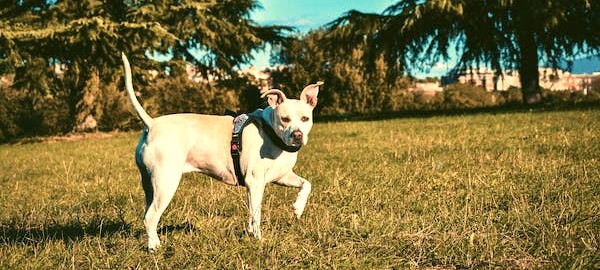Dog owners worldwide recognize the importance of regular exercise and activity for their furry companions, especially for certain breeds. Among these breeds are the ‘bully’ breeds – a term often used to refer to dogs such as American Pit Bull Terriers, Staffordshire Bull Terriers, and Bulldogs. These breeds possess a distinct combination of energy, strength, and athleticism that necessitates a tailored approach to their exercise routines. This article will delve into the specific exercise and activity needs of bully dog breeds, offering strategies for keeping them fit, happy, and healthy.
Fit and Fabulous: Tailoring Exercise Routines to Meet Bully Breed Needs
Bully breeds are known for their muscular build and energetic nature, traits that demand a dedicated and well-thought-out exercise routine. However, not all forms of exercise are suitable for these breeds. Due to their unique physical characteristics and potential health issues, it’s crucial to tailor their exercise routines to their specific needs.
To start with, bully breeds require a moderate amount of exercise daily to maintain their physical health and to keep their high energy levels in check. Experts recommend at least an hour of physical activity per day, which can be split into two or more sessions. This should involve a combination of cardio exercises, such as running or brisk walking, and strength-building exercises like tug-of-war or fetch with a heavy toy.
However, it’s important to note that while bully breeds are naturally athletic, they can also be prone to certain health issues like hip dysplasia, arthritis, and cardiac problems. Therefore, their exercise routines should be carefully planned to avoid excessive strain on their joints and heart. Low-impact activities like swimming or walking on soft surfaces can be beneficial in such cases.
Tailoring exercise routines for bully breeds also involves considering their mental stimulation. These breeds are not only physically active but also mentally sharp. Incorporating activities that challenge their minds, such as puzzle toys or agility training, can help keep them mentally satisfied and prevent destructive behaviors borne out of boredom.
Active Allies: Strategies for Keeping Bully Breeds Happy and Healthy Through Exercise
Keeping bully breeds active and happy involves more than just physical exercise. It’s about creating a balanced routine that caters to their physical, mental, and emotional needs. Here are some strategies that can help in achieving this balance.
First, consider incorporating structured play into their daily routine. This could involve fetch games, agility training, or even simple tricks. These activities not only provide physical exercise but also work their minds and enforce positive behaviors.
Second, socialization should be a key component of their exercise routine. Bully breeds tend to be sociable and enjoy the company of other dogs. Regular visits to the dog park or arranging playdates with other dogs can offer them the opportunity to socialize while also getting a good amount of physical activity.
Third, always keep an eye on their tolerance levels. Bully breeds are often eager to please and may push themselves beyond their limits to keep up with their owners. Monitor their breathing, gait, and overall demeanor during exercise, and don’t hesitate to cut the session short if they show signs of fatigue or discomfort.
Energy Outlets: Fulfilling the Exercise Requirements of Bully Dog Companions
A crucial aspect of keeping bully breeds fit and happy is providing them with adequate outlets for their energy. Without appropriate energy outlets, these breeds can become frustrated and potentially develop behavioral problems.
Regular exercise sessions are, of course, the primary energy outlet for bully breeds. However, these sessions should be varied and engaging to keep them interested. Mixing up their exercise routine with different activities can help prevent them from getting bored.
Apart from regular exercise, bully breeds also benefit from having access to a variety of toys. Durable chew toys, interactive toys, and puzzle toys can all provide mental stimulation and a physical outlet for their energy.
Another potential energy outlet for bully breeds is training. Whether it’s obedience training, trick training, or agility training, these activities can help channel their energy into something productive and strengthen the bond between dog and owner.
Healthy Habits: Promoting Physical Fitness and Mental Well-being in Bully Breeds
Physical fitness and mental well-being go hand in hand for bully breeds. While regular exercise and activity play a key role in their physical health, they also significantly contribute to their mental well-being.
Exercise can help reduce anxiety and stress in bully breeds, leading to a happier and more balanced dog. It can also help curb behavioral issues such as excessive barking, chewing, or digging, which are often signs of pent-up energy or boredom.
In addition, regular exercise and mental stimulation can promote better sleep in bully breeds. Just like humans, dogs need quality sleep to function at their best. A tired dog is a well-behaved dog, and a good amount of physical activity and mental stimulation each day can ensure your bully breed gets a good night’s sleep.
Finally, exercise and activity can strengthen the bond between you and your bully breed. Whether it’s through daily walks, play sessions, or training, spending quality time together can foster trust and affection, leading to a stronger and more fulfilling relationship.
In conclusion, the exercise and activity needs of bully dog breeds are unique and multifaceted. By understanding these needs and implementing a tailored and balanced exercise routine, owners can ensure their bully breeds stay fit, healthy, and happy. Remember, a well-exercised bully breed is not only a joy to be around but also a loyal and loving companion.









